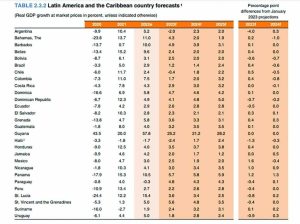Home News Guyana’s oil & gas sector sets up positive economic outlook – World...
Driven mainly by its burgeoning oil and gas sector, Guyana’s economic outlook for 2023 continues to be at an unprecedented high, as the country is set to record double-digit growth. 
This is according to the World Bank’s latest report – Global Economic Prospects, which was published on June 6.
The report states that growth in Latin America and the Caribbean (LAC) is expected to slow sharply, from 3.7 per cent in 2022 to 1.5 per cent in 2023. With regard to the Caribbean specifically, economic output by countries is projected to expand by 5.1 per cent this year, compared to the strong 7.9 per cent growth recorded last year.
“The subregion’s outlook partly reflects the oil boom in Guyana, where GDP (Gross Domestic Product) is expected to grow by 25.2 per cent this year and 21.2 per cent in 2024 as production at new oil fields continues to ramp up,” the report detailed.
Currently, United States oil major ExxonMobil and its co-venturers – Hess Corporation and CNOOC – are producing crude at the Liza Phase One and Liza Phase Two development fields in the Stabroek Block offshore Guyana. While the Liza Destiny and Liza Unity floating, production, storage and offloading (FPSO) vessels are being used to pump approximately 375,000 barrels of oil per day (bpd) from those two operations, production is expected to further ramp up later this year when the third FPSO – the Prosperity – becomes operational. This new vessel, from the Payara development, will add another 220,000 barrels of daily capacity from Stabroek Block.
The US oil giant has set a target to have at least six FPSOs online by the end of 2027, bringing Guyana’s production capacity to more than 1.2 million barrels per day.
Nevertheless, based on the recent World Bank report, Guyana is the only country with a double-digit growth projection, since economic output in the other Caribbean nations is expected to grow at an average rate of 3.3 per cent in 2023, boosted by continued recovery in tourism and by buoyant remittances.
Guyana’s outlook for 2023 is followed by a 5.7 per cent growth in St Vincent and the Grenadines, and a 4.9 per cent growth in Barbados. This is contrasted by Haiti’s -2.4 per cent projection, as the country’s economy is expected to continue to contract amid increased violence and instability. This, it was noted, will further worsen the country’s food security situation, as almost half of households have recently experienced limitations in accessing food, as reported by the United Nations Food and Agriculture Organization (FAO) in 2022.
Meanwhile, the World Bank report further highlighted that, for 2024, apart from Guyana, the Caribbean is expected to grow by 3.9 per cent, as external demand from advanced economies recovers.
The report went on to outline that the slowdown of growth in the LAC region is expected to dampen even further, especially with core and headline inflation above most central bank targets across the region, causing monetary policy to likely remain tight in the near term. It added, too, that policy uncertainty in some countries is damaging business and consumer confidence, while downside risks to the baseline forecast include slower growth in major trading partners, as well as tighter monetary policies and renewed financial stress in advanced economies, which would have adverse spillovers in the region through weaker trade or more restrictive financial conditions.
Moreover, it was noted that climate change also poses a significant risk, given the increasing frequency of extreme weather events.
According to the World Bank, potential output growth in the LAC region has weakened in the past decade, 2010-2019. In this current decade, it is expected to be the lowest among emerging market and developing economy (EMDE) regions as a result of below-average growth of both total factor productivity and the labour force.
“As LAC economies move on from pandemic-driven recessions and subsequent recoveries, low potential growth underlies the generally weak growth prospects for the region,” the report stated.
Moreover, the Global Economic Prospects report went on to project that global growth will decelerate from 3.1 per cent in 2022 to 2.1 per cent this year.
“The surest way to reduce poverty and spread prosperity is through employment — and slower growth makes job creation a lot harder,” said World Bank Group President Ajay Banga. He added, “It’s important to keep in mind that growth forecasts are not destiny. We have an opportunity to turn the tide, but it will take us all working together.” (G8)
